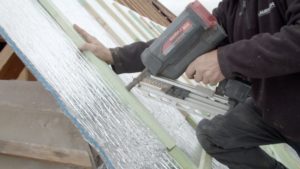8 Common Problems with Steel Buildings

Steel buildings have become a popular choice for a range of needs, primarily for commercial warehouses and office structures. Their durability, cost-effectiveness, and quick assembly make them an attractive option. But like any construction material, steel is not without its drawbacks.
Before deciding if steel is right for your next project, it’s important to understand these common problems to help you take proactive measures to mitigate these issues.
1. Corrosion and Rust
One of the biggest concerns with steel buildings is corrosion, because steel is prone to rust when exposed to moisture and oxygen. This issue is worse in coastal areas or regions with high humidity and salt in the air. Corrosion not only affects the visual appeal of the building, but also compromises its structural integrity over time and can become a safety issue.
Possible Solutions
Regular maintenance and the application of protective coatings, such as galvanization or paint, can significantly reduce the risk of rust. Additionally, using weather-resistant steel alloys and incorporating proper drainage systems to keep water away from the steel can help mitigate this problem.
2. Thermal Expansion and Contraction
When the temperature changes, steel can expand and contract – this characteristic can lead to structural issues if not accounted for during the design and construction phases. Thermal movement can cause warping, bending, and even cracking in extreme cases, negatively impacting the overall stability of the building.
Possible Solutions
To address this, builders can incorporate expansion joints and flexible connections into the design. These elements allow the steel to move without causing damage to the structure. Using insulation materials that accommodate thermal movement can also help maintain the building’s integrity.
3. Condensation and Moisture
Steel buildings are also susceptible to condensation, especially in areas with significant temperature fluctuations. When warm, moist air comes into contact with the cool surface of the steel, condensation forms. This can lead to mold growth, water damage, and rust that affect the longevity and safety of the building.
Possible Solutions
Proper insulation and ventilation are critical to controlling condensation. Vapor barriers, reflective insulation, and dehumidifiers can help manage moisture levels inside the building. Ensuring adequate airflow with vents and fans can also prevent condensation buildup.
4. Noise
Steel buildings can be louder than other materials, especially during heavy rain or hailstorms. The sound of rain hitting the metal roof can be overwhelming, creating a loud and distracting environment inside. This noise issue can be problematic for commercial buildings, offices, and other spaces where it negatively impacts those inside.
Possible Solutions
Acoustic insulation materials can be installed to reduce noise levels; these materials absorb sound and dampen vibrations, creating a quieter interior environment. Using thicker panels or adding an extra layer of insulation can also help mitigate noise issues.
5. Insulation Challenges
Insulating steel buildings is known to be challenging because of the material’s high thermal conductivity. Without proper insulation, steel buildings can become excessively hot in the summer and cold in the winter, causing uncomfortable indoor conditions and higher energy costs.
Possible Solutions
High-quality insulation materials, such as spray foam, fiberglass, or rigid foam boards, can effectively insulate steel buildings. Reflective insulation can also help by reflecting radiant heat away from the building. A well-designed insulation system will improve energy efficiency and maintain a comfortable indoor climate all year.
6. Structural Weaknesses
Like any building, the quality of construction plays a crucial role in the performance of steel structures. Poor workmanship, substandard materials, and inadequate design can lead to structural weaknesses, affecting the building’s safety and durability.
Possible Solutions
Ensuring that the construction is carried out by experienced and qualified professionals is critical for steel buildings. Builders should always follow industry standards and guidelines, use high-quality materials, and conduct regular inspections during and after construction to prevent structural issues.
7. Pest Infestations
Compared to wooden structures, steel buildings are less vulnerable to pests, but that doesn’t mean they are completely immune to this problem. Gaps, cracks, and improperly sealed areas can provide entry points for insects or rodents, leading to infestations that ultimately damage insulation and other materials.
Possible Solutions
Sealing all potential entry points and using pest-resistant insulation materials can help keep pests at bay. Regular inspections and maintenance can also identify and address any infestation issues early on.
8. Fire Resistance
While steel is non-combustible, it is not entirely fireproof. High temperatures can weaken steel, reducing its load-bearing capacity and potentially leading to structural failure. Fire protection measures are crucial to ensuring the safety of steel buildings.
Possible Solutions
Implementing fire-resistant coatings and incorporating fireproof materials in construction can enhance the building’s fire resistance. Fire detection and suppression systems, such as sprinklers and alarms, are also vital for early detection and response to fires.
Maintain Steel Buildings with Quattro Insulation
Steel buildings are popular because they have many advantages – but they also have their own challenges that require proactive measures and investing in quality materials.
Quattro Insulation specializes in providing solutions to many of these challenges, ensuring that your steel building stands the test of time.


